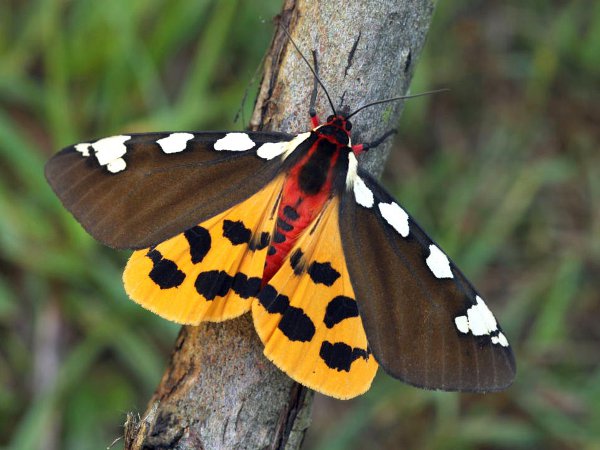Ecaille brune : Différence entre versions
m (A déprotégé « Ecaille brune ») |
m (A déprotégé « Ecaille brune ») |
||
| (10 révisions intermédiaires par 2 utilisateurs non affichées) | |||
| Ligne 1 : | Ligne 1 : | ||
[[Category:Insectes]] | [[Category:Insectes]] | ||
| − | <br> | + | [[Image:Ecaille brune Pericallia matronula Daniel Morel.jpg|Image:Ecaille_brune_Pericallia_matronula_Daniel_Morel.jpg]]<br> Ecaille brune ''Pericallia matronula'' - photo © Daniel Morel |
====== Etymologie ====== | ====== Etymologie ====== | ||
| − | + | *'''Nom latin''': ''Pericallia matronula'' | |
| − | + | *'''Autre nom''' : La Matrone. | |
| − | + | *'''Nom anglais''' : The Matron, Large Tiger Moth. | |
| + | *'''Famille''' : '''Arctiidae'''. | ||
====== Description ====== | ====== Description ====== | ||
| − | + | *'''Taille''' : mm | |
| − | + | *La plus grande des Écailles françaises et '''l'une des plus rares'''. | |
| − | |||
====== Répartition ====== | ====== Répartition ====== | ||
| − | + | *'''Eurasiatique'''. | |
| − | + | *'''France''' : les Alpes constituent la limite ouest de sa vaste répartition, depuis la Sibérie orientale. | |
| − | |||
====== Habitat ====== | ====== Habitat ====== | ||
| − | + | *La conservation des '''haies''' et des '''bosquets forestiers''' contribue à la préservation de ses populations. | |
| − | + | ====== Ecologie ====== | |
| − | + | *Les '''chenilles''' se développent sur différentes plantes basses et arbustives, durant 2 ans. | |
| − | ====== | + | *'''L'adulte''' (imago) ne s'alimente pas. |
| − | + | *'''Période d'apparition''' : juin-août selon l'altitude. | |
| − | |||
| − | |||
| − | |||
| − | |||
| − | - | ||
| − | |||
====== Statut ====== | ====== Statut ====== | ||
| − | + | *En régression depuis plus d'un siècle. | |
| − | + | *'''Espèce protégée par l'arrêté du 23 juillet 1993'''. | |
| − | + | ====== Bibliographie ====== | |
| − | ====== | + | *Bebbington John & Lewington Richard (2007) - '''Guide to the hawkmoths of the British Isles'''. Edition Field Studies Council (FSC). |
| − | + | *Leraut Patrice (2006) - '''Papillons de nuit d'Europe, bombyx, sphinx, écailles...''' VOL I. NAP éditions. | |
| − | --- | + | *Leraut Patrice (2009) - '''Papillons de nuit d'Europe, géomètres''' VOL II. NAP éditions. |
| + | *Lewington Richard (2006) - '''Guide to the day-flying moths of Britain'''. Edition Field Studies Council (FSC) | ||
| + | *Manley Chris (2008) - '''British moths and butterflies, a photographic guide'''. Edition A & C Black. | ||
| + | *Robineau Roland (2007) -'''Guide des papillons nocturnes de France''', plus de 1620 espèces décrites et illustrées. Edition Delachaux & Niestlé. | ||
| + | *Skinner Bernard (2009) -'''Colour identification guide to moths of the British isles'''. Edition Apollo Books. | ||
| + | *Townsend M. & Waring P. (2007) -'''Concise guide to the moths of great Britain and Ireland'''. Edition British Wildlife Publishing | ||
| + | *Waring Paul & Townsend Martin (2009)- '''Field guide to the moths of great Britain and Ireland'''. Edition British Wildlife Publishing. | ||
| + | *Young Mark (1997) -'''Natural History of Moths'''. Edition T & AD Poyser Ltd (A & C Black). | ||
Version actuelle datée du 29 septembre 2015 à 08:19

Ecaille brune Pericallia matronula - photo © Daniel Morel
Etymologie[modifier]
- Nom latin: Pericallia matronula
- Autre nom : La Matrone.
- Nom anglais : The Matron, Large Tiger Moth.
- Famille : Arctiidae.
Description[modifier]
- Taille : mm
- La plus grande des Écailles françaises et l'une des plus rares.
Répartition[modifier]
- Eurasiatique.
- France : les Alpes constituent la limite ouest de sa vaste répartition, depuis la Sibérie orientale.
Habitat[modifier]
- La conservation des haies et des bosquets forestiers contribue à la préservation de ses populations.
Ecologie[modifier]
- Les chenilles se développent sur différentes plantes basses et arbustives, durant 2 ans.
- L'adulte (imago) ne s'alimente pas.
- Période d'apparition : juin-août selon l'altitude.
Statut[modifier]
- En régression depuis plus d'un siècle.
- Espèce protégée par l'arrêté du 23 juillet 1993.
Bibliographie[modifier]
- Bebbington John & Lewington Richard (2007) - Guide to the hawkmoths of the British Isles. Edition Field Studies Council (FSC).
- Leraut Patrice (2006) - Papillons de nuit d'Europe, bombyx, sphinx, écailles... VOL I. NAP éditions.
- Leraut Patrice (2009) - Papillons de nuit d'Europe, géomètres VOL II. NAP éditions.
- Lewington Richard (2006) - Guide to the day-flying moths of Britain. Edition Field Studies Council (FSC)
- Manley Chris (2008) - British moths and butterflies, a photographic guide. Edition A & C Black.
- Robineau Roland (2007) -Guide des papillons nocturnes de France, plus de 1620 espèces décrites et illustrées. Edition Delachaux & Niestlé.
- Skinner Bernard (2009) -Colour identification guide to moths of the British isles. Edition Apollo Books.
- Townsend M. & Waring P. (2007) -Concise guide to the moths of great Britain and Ireland. Edition British Wildlife Publishing
- Waring Paul & Townsend Martin (2009)- Field guide to the moths of great Britain and Ireland. Edition British Wildlife Publishing.
- Young Mark (1997) -Natural History of Moths. Edition T & AD Poyser Ltd (A & C Black).